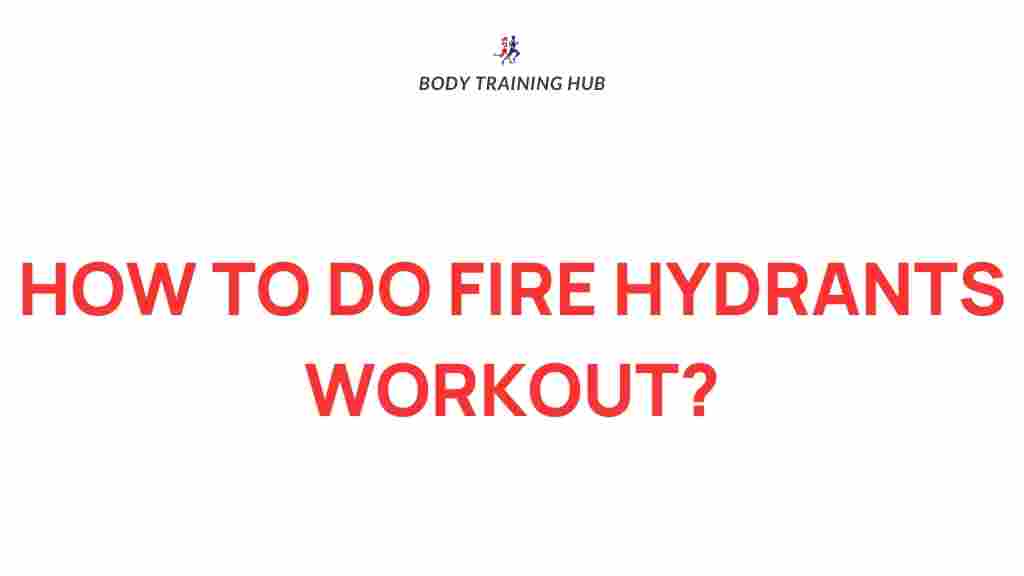Unleash Your Potential with Fire Hydrant Workouts
In the world of fitness, there are countless exercises that promise to tone, strengthen, and sculpt your body. Among these, fire hydrant workouts stand out as a highly effective way to target your glutes, strengthen your core, and enhance your overall fitness routine. This article will guide you through everything you need to know about fire hydrant exercises, including their benefits, proper techniques, a detailed workout routine, troubleshooting tips, and much more.
What Are Fire Hydrant Workouts?
Fire hydrant workouts are a fantastic exercise designed to work your glute muscles, particularly the gluteus medius and gluteus maximus. Named after the movement of a dog lifting its leg to a fire hydrant, this exercise can be performed with minimal equipment and is suitable for all fitness levels.
Benefits of Fire Hydrant Workouts
- Targeted Glute Activation: Fire hydrants specifically engage the glute muscles, making them ideal for those looking to enhance their lower body strength.
- Core Strengthening: This exercise also requires core stability, thereby helping to strengthen your abdominal muscles.
- Improved Hip Mobility: Regular practice of fire hydrants can enhance hip flexibility and range of motion.
- Injury Prevention: Strengthening the glutes can help prevent injuries by stabilizing the hips and knees during other physical activities.
- Versatility: Fire hydrants can be easily modified to increase or decrease intensity, making them suitable for beginners and advanced fitness enthusiasts alike.
How to Perform Fire Hydrant Exercises
Follow these steps to ensure you perform fire hydrant workouts correctly and effectively:
Step 1: Get into Position
Begin on all fours on a mat, with your hands directly under your shoulders and your knees under your hips. Keep your back flat and engage your core for stability.
Step 2: Lift Your Leg
Keeping your knee bent at a 90-degree angle, lift your right leg out to the side, ensuring that your hip remains in line with your body. Avoid twisting your torso; your movement should come strictly from your hip joint.
Step 3: Hold and Return
At the top of the movement, hold for a moment to engage your glutes fully. Then, lower your leg back down to the starting position. Repeat for the desired number of reps.
Step 4: Switch Sides
After completing your reps on the right side, switch to the left side and repeat the exercise.
Fire Hydrant Workout Routine
Here is a simple yet effective fire hydrant workout routine you can incorporate into your fitness regimen:
Warm-Up (5-10 minutes)
- Dynamic stretches (leg swings, hip circles, etc.)
- Light cardio (jogging in place or jumping jacks)
Fire Hydrant Workout (3 sets)
- Fire Hydrants: 15-20 reps per side
- Fire Hydrant Pulses: At the top of the fire hydrant movement, pulse your leg up for 10-15 reps before lowering.
- Fire Hydrant with Extension: After lifting your leg to the side, extend it straight back for an additional 10-15 reps.
Core Activation (Optional)
- Plank: 30-60 seconds
- Side Plank: 30 seconds on each side
Cool Down (5-10 minutes)
- Gentle stretching focusing on the glutes, hips, and lower back.
Tips for Maximizing Your Fire Hydrant Workouts
- Focus on Form: Ensure you maintain proper form to avoid injury and maximize effectiveness.
- Engage Your Core: Keep your core tight throughout the exercise to enhance stability and strength.
- Use Resistance Bands: For added difficulty, consider using resistance bands around your thighs to increase the challenge.
- Incorporate Variations: Mix in different variations of the fire hydrant to keep your routine fresh and exciting.
Troubleshooting Common Issues
Even with proper guidance, you may encounter some challenges while performing fire hydrant workouts. Here are a few common issues and how to address them:
1. Difficulty Maintaining Balance
If you find it hard to balance, try performing the exercise with your hands on a wall or a sturdy surface for additional support.
2. Back Pain
Ensure your core is engaged and your back is flat. If pain persists, consider reducing the range of motion or consulting with a fitness professional.
3. Limited Range of Motion
If you cannot lift your leg as high as desired, work within your comfortable range and gradually increase as your strength improves.
Incorporating Fire Hydrant Workouts into Your Fitness Routine
To maximize the benefits of fire hydrant workouts, consider the following tips for integration:
- Combine with Other Exercises: Pair fire hydrants with squats, lunges, or deadlifts to create a comprehensive lower body workout.
- Schedule Regularly: Incorporate fire hydrants into your routine at least 2-3 times per week for optimal strength and toning results.
- Track Your Progress: Keep a fitness journal to monitor your reps, sets, and any improvements in strength and endurance.
Conclusion
Fire hydrant workouts are an excellent way to strengthen your glutes, improve core stability, and enhance your overall fitness. By incorporating these exercises into your regular routine, you can unleash your potential and achieve your fitness goals. Remember to focus on proper form, listen to your body, and gradually increase the intensity of your workouts. For more exercise tips and fitness routines, check out our fitness blog. And for additional resources on core strength and stability, visit this external site.
Now, get ready to incorporate fire hydrant workouts into your routine and feel the difference in your strength and fitness levels!
This article is in the category Strength & Recovery and created by BodyTraining Team
